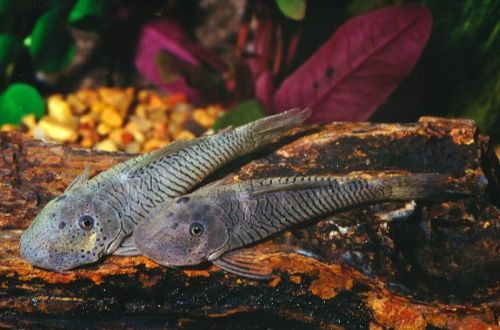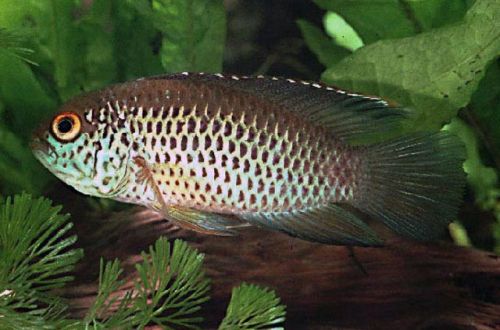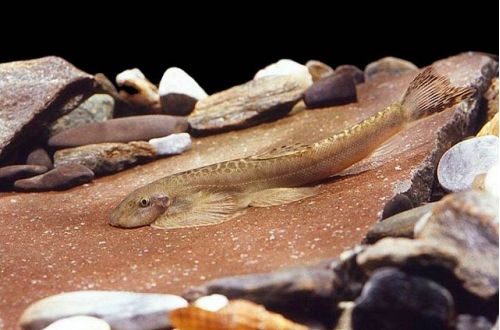
“Striped Bulldog”
The striped bulldog catfish, scientific name Chaetostoma formosae, belongs to the family Loricariidae (Mail catfish). Difficult to maintain fish due to the special requirements for the diet and specific living conditions. Not recommended for beginner aquarists.

Contents
Habitat
Comes from South America. It occurs in the upper Orinoco basin, in particular in the Meta (río Meta) and Guaviare (río Guaviare) river systems flowing through the territory of eastern Colombia. Fish inhabit fast-flowing streams and rivers. A typical biotope is a channel consisting of rocks interspersed with stones and boulders covered with a layer of algae. Aquatic vegetation is usually absent. The water is translucent. Its hydrochemical composition is variable and can change significantly during the day due to heavy tropical showers.
Brief information:
- The volume of the aquarium – from 100 liters.
- Temperature – 20-24°C
- Value pH — 6.5–7.8
- Water hardness – 8–26 dGH
- Substrate type — stony
- Lighting – bright
- Brackish water – no
- Water movement – moderate or strong
- The size of the fish is up to 10 cm.
- Nutrition – algae-based food
- Temperament – peaceful
- Content alone or in a group
Description
Adult males reach a length of 9–10 cm, females are smaller – no more than 7 cm. The catfish has an elongated somewhat flattened body with a large head on the lower part of which there is a sucker mouth. This structure of the mouth allows it to securely attach to surfaces, resisting the flow, and scrape off algae. The first rays of the fins are thickened, turning into sharp spikes. The integuments of the body are solid and consist of separate sections – plates covered with small spines. The coloration is gray with dark stripes at the junction of the plates, the pattern on the head consists of dots.
Food
In nature, they feed on algae and the microorganisms that inhabit them (invertebrates, insect larvae, etc.). In a home aquarium, the diet should be similar. Unlike other herbivorous catfish, pieces of green vegetables and fruits cannot become the basis of the diet. Algae is a must, along with frozen or fresh brine shrimp, daphnia, bloodworms, etc. If natural algae growth is not possible in the main tank, it may be necessary to install a separate brightly lit tank where conditions for their active growth will be created. Periodically, “overgrown” in such conditions, decorative elements are placed in the main aquarium for “cleaning”, and then returned back.
Maintenance and care, arrangement of the aquarium
The optimal size of the aquarium for 2-3 fish starts from 100 liters. Successful maintenance of the Striped Bulldog catfish is possible in very clean water rich in dissolved oxygen. It is recommended to install a redundant filtration system providing at least 10 cleaning revolutions per hour. That is, for a tank of 100 liters, a filter must be selected that will pump over 1000 liters of water through itself in one hour. Such installations will also provide a fairly strong internal current, which is quite acceptable for this type of catfish.
Given such turbulent conditions, the set of design elements is reduced to a substrate of large stones and boulders, as well as massive natural snags – whose surface is an excellent place for algae to grow. Bright lighting will also serve as an incentive for their growth. To diversify the interior landscape, you can add a few artificial plants.
Behavior and Compatibility
A peaceful fish, and although it prefers to form territories, aggression in its behavior is not observed. Despite this, there will be problems with the choice of tankmates, since only a small number of fish are able to live in a similar environment in conditions of strong current. These include some related species from among the Kolchuzhny catfish, as well as loaches.
Breeding / breeding
At the time of writing, only fragmentary information about breeding this species in home aquaria was available. Apparently, the breeding strategy boils down to the fact that the care of future offspring depends entirely on the males protecting the clutch and fry until they become free-swimming.
Fish diseases
The cause of most diseases is unsuitable conditions of detention. A stable habitat will be the key to successful keeping. In the event of symptoms of the disease, first of all, the quality of the water should be checked and, if deviations are found, measures should be taken to correct the situation. If symptoms persist or even worsen, medical treatment will be required. Read more about symptoms and treatments in the Aquarium Fish Diseases section.





